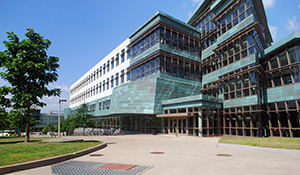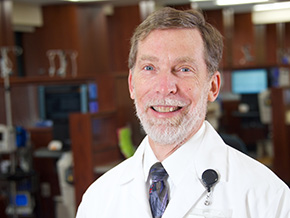Dec. 1, 2014:
A conversation with George Weiner, MD, director of Holden Comprehensive Cancer Center at the University of Iowa and the C.E. Block Chair of Cancer Research and professor of internal medicine at the University of Iowa. Dr. Weiner has led a statewide collaborative to reduce the burden of cancer in Iowa, served on committees within the National Cancer Institute, and just began a two-year term as president of the Association of American Cancer Institutes (AACI), which comprises 92 leading cancer research centers in the United States.
Q: What kind of impact do you see the Big Ten Cancer Research Consortium having on cancer clinical trials?
Every one of our institutions has an outstanding group of experts from a variety of specialties who work together to develop and test new ideas related to cancer prevention, early detection, and treatment. Can you imagine the difference we can make if we partner together? We will be able to share and test ideas quicker. It is imperative for us to do so. Research advances have demonstrated that cancer is much more complex at the molecular level than previously imagined. In essence, every cancer is unique and even the most “common” cancers are really rare cancers. This is both exciting and challenging. It is exciting because we are learning the best way to take care of cancer patients. It is challenging because finding enough patients who have the same molecular makeup to test new and promising treatments will be more difficult. To design better treatments in the future, scientists have to collaborate more than ever to assess our ideas. Working together, to partner on studies is going to be key to advance cancer medicine. Different from many other study consortia, the Big Ten Cancer Research Consortium will allow these multicenter trials to be done with a nimble organizational structure for optimal efficiency and scientific input.
Q: What are some strengths UI Holden Comprehensive Cancer Center brings to the consortium?
For one thing, at Holden we have integrated our research and medical teams into groups we call MOGs (Multidisciplinary Oncology Groups) that include both clinicians and laboratory-based investigators. This facilitates the ability of our clinicians to provide multidisciplinary care and gives our researchers the ability to see first-hand how their ideas are working in the clinical setting. Both clinicians and investigators get to hear first-hand about the issues faced in the clinic and recent scientific advances which help spawn new ideas.
 In addition, we have a program we call our Molecular Epidemiology Resources (MERs). It is a technical name, but simply stated, it is a prospective registry linked to biospecimens. For several cancer types we gather a blood sample and a tumor sample from participating patients and also collect detailed clinical information. We track what treatments each patient receives and how well each treatment works, and also collect information on quality of life and other health problems. We have data on close to 5,000 patients. The MERs have the potential to yield results that change care based on the ability to link molecular findings with robust clinical information. Our first MER started in lymphoma in 2002, in collaboration with the Mayo Clinic, as part of our joint lymphoma SPORE. Results from the lymphoma MER are changing care of patients with this type of cancer, and we expect the other MERs to do the same. We are hopeful that some of the results coming from the MERs will lead to ideas that can be tested in clinical trials run through the Big Ten Cancer Research Consortium.
In addition, we have a program we call our Molecular Epidemiology Resources (MERs). It is a technical name, but simply stated, it is a prospective registry linked to biospecimens. For several cancer types we gather a blood sample and a tumor sample from participating patients and also collect detailed clinical information. We track what treatments each patient receives and how well each treatment works, and also collect information on quality of life and other health problems. We have data on close to 5,000 patients. The MERs have the potential to yield results that change care based on the ability to link molecular findings with robust clinical information. Our first MER started in lymphoma in 2002, in collaboration with the Mayo Clinic, as part of our joint lymphoma SPORE. Results from the lymphoma MER are changing care of patients with this type of cancer, and we expect the other MERs to do the same. We are hopeful that some of the results coming from the MERs will lead to ideas that can be tested in clinical trials run through the Big Ten Cancer Research Consortium.
Q: What kind of scientific advances happening at UI Holden Comprehensive Cancer Center are changing the way we diagnose and treat cancer?
There are many examples, but I’ll go back to how we used the MERs and a collaborative effort to change care for lymphoma patients. Traditionally patients with diffuse large B-cell lymphoma — the most common form — who went into remission were told to have CT scans annually for five years to ensure they were still in remission. The Iowa/Mayo team found if a patient is still in remission a year after chemotherapy is completed, the patient’s lifespan is no different than age-match controls and the chance of additional routine CT scans finding something important is very low. Based on this result, we are no longer doing routine CT scans on these patients if they are in remission one year after completing therapy. The anxiety patients feel about getting a scan is gone and the radiation exposure is gone. If this change were adopted nationally, we could save about $500 million by not doing annual CT scans on these patients. The practice is starting to change around the country.
This is a good example of how a collaborative approach helped improve care for patients. Imagine what our Big Ten community of cancer center scientists can accomplish with all of our resources and mental power working together.
Q: How will being a part of the Big Ten Cancer Research Consortium differ from other collaborative efforts of which your cancer center has been a part?
We think there is great potential to raise awareness and collaborate given that we are already connected through an athletic conference. In addition, we know each other well. We have worked together in many settings such as by serving on each other’s Scientific External Advisory Boards, and we share the same mission. When it comes to our commitment to leveraging scientific advances to help patients, we speak the same language. Even though it is still in the early stage, the Big Ten Cancer Research Consortium is starting to yield results. We are starting to open clinical trials together. Dr. Daniel Vaena is an outstanding clinical investigator who is Iowa’s lead in the Big 10 CRC. He tells me clinical investigators across the Big Ten are very excited about working together, and the exchange of ideas and concepts has been fantastic. We know that cancer research of the future is going to require greater collaboration and the Big Ten CRC fits perfectly into that mindset. At Holden we are excited about our collective future.
About the Big Ten Cancer Research Consortium: The Big Ten Cancer Research Consortium creates a unique team-research culture to drive science rapidly from ideas to treatment-changing paradigms. Within this innovative environment, today’s research leaders collaborate with and mentor the research leaders of tomorrow with the unified goal of improving the lives of all patients with cancer.
About the Big Ten Conference: The Big Ten Conference is an association of world-class universities whose member institutions share a common mission of research, graduate, professional, and undergraduate teaching and public service. Founded in 1896, the Big Ten has sustained a comprehensive set of shared practices and policies that enforce the priority of academics in student-athletes’ lives and emphasize the values of integrity, fairness, and competitiveness. The broad-based athletic programs of the 14 Big Ten institutions provide nearly $200 million in direct financial aid to almost 9,500 student-athletes for more than 11,000 participation opportunities on 350 teams in 42 different sports. The Big Ten sponsors 28 official conference sports, 14 for men and 14 for women, including the addition of men’s and women’s lacrosse as official sports for the 2014-15 academic year. For more information, visit www.bigten.org.















Subscribe to the Big Ten CRC Newsletter X
X Facebook
Facebook YouTube
YouTube